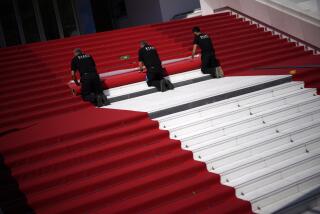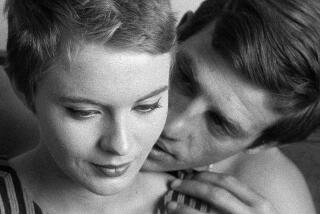More Than a Laugh Fest
- Share via
The Nuart is presenting the same four Jacques Tati films that were shown two years ago at the Monica 4-Plex--but with a difference: “Jour de Fete” (1949), which will screen Friday through Wednesday, will boast a newly restored color print. “Mr. Hulot’s Holiday” (1953) screens Saturday and Sunday at noon, and “Playtime” (1968) and “Mon Oncle” (1958) screen as a double feature next Thursday. Working in films since 1932 as an actor, writer and director of shorts, Tati (1908-1982) was a tall, dashing, silver-haired sophisticate--the grandson of the last Russian czar’s ambassador to France, in fact--a poised charmer in contrast to the loping, forward-leaning klutz he portrayed in his films. He was the true heir of Hollywood’s legendary silent comedians, and during a 1972 Hollywood visit, he acknowledged their influence. “All the great American comedians bring something to me,” he said. Dialogue presented no problems for Tati--his people speak in everyday fashion while his humor resides primarily in the visual.
Tati made his feature debut with “Jour de Fete,” which reveals his debt to Buster Keaton in his physical moves and in his constant tangle with man’s inventions. He casts himself as the sweet-natured but stunningly inept postman in the village of St. Severe, which is eagerly anticipating a carnival. There’s a lot of Renoir in Tati’s love of the pastoral and country people, whom he observes with such affection.
With “Mr. Hulot’s Holiday” (1953) Tati made his most famous film, casting himself in the title role as a free-spirited, near-mute pipe-smoker who arrives for a week’s vacation at the beach in his sputtering, ancient mini-car. Staying at a small, stuffy beach resort hotel where propriety reigns, Hulot identifies with dogs and mischievous children rather than the other visitors.
Tati pokes fun at middle-class mores but with unyielding good nature as Hulot runs into no end of hassles, such as inadvertently finding himself in a funeral receiving line only to have to stifle a laugh when he’s tickled by a feather on a little old lady’s hat.
With its inspired sight gags and comic mishaps, the seemingly artless “Mr. Hulot’s Holiday” is as blissful as a sunny day at the beach.
The Oscar-winning “Mon Oncle” (1958), in which Tati returned as Hulot, finds the filmmaker in a no less humorous, yet more critical, mood. “Hulot,” we discover, lives in a charming ancient community gradually being overtaken by stark modern construction. Nearby, his silly sister and her equally plump husband live with their small son--
naturally adoring of his oddball uncle--in a sleek, modern villa loaded with weird-sounding mechanical gadgetry. The brother-in-law, an executive in a plastic pipe factory, kindly gets Hulot a lowly job--and you can see disaster coming.
Although the film is a justly famous lament on the depersonalizing quality of modern life, it ironically looks different today: That modern house is actually a classic example of ‘50s architecture, anticipating both high technology and Post-Modernism. The geometric Atomic Age furnishings, right down to the ashtrays, would bring a fortune on Melrose, and its gaudy American cars are, of course, now expensive collectors’ items.
With “Playtime,” Hulot returned, although peripherally, as a job seeker in a skyscraper canyon. Only the buildings’ reflections of the Eiffel Tower and the domed cathedral in Montmartre let us know we are actually in Paris. Tati’s protest of the artificiality of the modern world furthers both his notion that such an environment can turn us into robots and that mishaps and laughter can return us to our humanity, if only momentarily. Never was Tati’s mastery of sound effects more inspired than in “Playtime,” a commercial disaster at the time of its release that nevertheless may be Tati’s true masterpiece. (310) 478-6379.
More to Read
Only good movies
Get the Indie Focus newsletter, Mark Olsen's weekly guide to the world of cinema.
You may occasionally receive promotional content from the Los Angeles Times.






